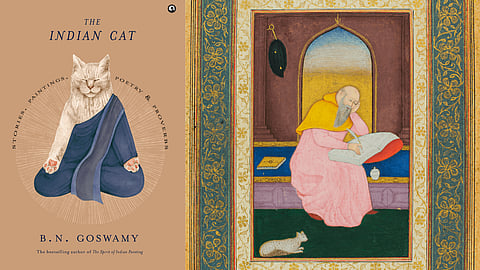
- HOMEGROWN WORLD
- #HGCREATORS
- #HGEXPLORE
- #HGVOICES
- #HGSHOP
- CAREERS
- ABOUT US
- CONTACT US

Dr. B.N. Goswamy was no stranger to the phenomenon of a ‘cold encounter’ — coming across a story with no preface whatsoever. The Padma Shri winning art critic and historian meandered into back alleys of mythology when the shadow of a cat lengthened across his scepticism.
Whether it was his son Apu who played saviour to strays, calling them outlandish names like Katja or conversations with museologist C. Sivaramamurti about the marjara-nyaya (unconditional surrender to divinity like a helpless kitten), Dr. Goswamy couldn’t shake off this spirit animal that always landed on its feet.
This initiation into the cult of the feline was one cold encounter that compelled him to put together a bizarre compendium titled The Indian Cat: Stories, Paintings, Poetry, and Proverbs published by Aleph Book Company in early October this year. Today, on the eve of his demise, we pay obeisance to the nine lives he witnessed on a journey through our heritage in pursuit of this mystical creature.
The parable of a cat falling asleep upon Prophet Muhammad’s finest robes at the time of evening prayer does not appear anywhere in official scriptures. Without a second thought, the Prophet is said to have torn off his sleeve, leaving Muezza to her slumber. Written by Sunni preacher Aḥmad al-Rifāʽī, many such tabbies have lurked in the shadows of Islamic teachings, their iridescent eyes quietly admonishing generations of Hadith scholars for having omitted their chronicles.
Dr. Goswamy, however, felt compelled to pick up at least 50 such threnodies by the scruff from Hitopadesha to Mahabharata in the first canto of his picture book. You will bristle with indignation at the conniving nature wrongly attributed to cats in the Jātaka Tales and how they came to be associated with the wiles of women distracting virginal Bodhisattvas from the rightful path, luring them like a flock of roosters to the butcher of sinfulness. In the next two sections, Dr. Goswamy rummages through the archives for close to 58 paintings and couplets that project more anthropocentric values upon these furry familiars, like grooming seductively for attention in a Pahari miniature or withering like a reclusive outlier in the poet Jibanananda Das' lament on existential solitude.
With scattered commentary underpinning each illustration, the cat transmogrifies ceaselessly from a keeper of secrets to divine vehicle for Hindu goddess Shashthi and back to serving as a fitting companion for women of the court in 18th century Kalighat portraiture. The deus ex machina salvages this requiem when Dr. Goswamy finally hands over the megaphone to these yowling victims of history. The cat-folk debunk incalculable myths and proverbs heaped upon them by mankind, enshrined in translations of wry epithets by Urdu satirist Shamsur Rahman Faruqi or even sonnets by contemporary Indian novelist Vikram Seth.
Thematically inspired from 'orientalists' like Annemarie Schimmel, the research for this compilation took more than two years and still does not begin to skim the surface. This domesticated entity has not only been chiselled into monolithic rocks at Mahabalipuram but also deified in other cultures across the world but as the author succinctly notes, cats elsewhere "have their own histories, their own tales, their own place in life." In another apocryphal episode that never made it into the Hadith, but remains a folklore special, the cat's brow was graced by Prophet Muhammad's blessing for having saved his life from a snake that had crawled up his sleeves. The Prophet stroked Muezza's head three times and that's where some cats get their stripes from.
While we remember Dr. Goswamy mostly for his erudite contributions to unpacking the artistry of Pahari masters and Indian miniaturists, it is this gentle homage he pays to his son Apu, who succumbed to cancer a few months ago, that catalysed my cold encounter with this scholar.
You can order your copy here.
